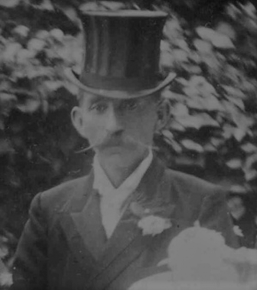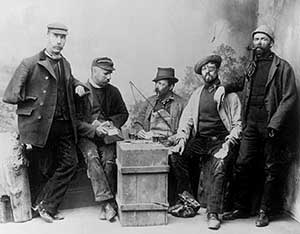
Emma Elizabeth Smith was a murder victim of mysterious origins in late-19th century London. Her killing was the first of the Whitechapel murders, and it is possible she was a victim of the serial killer known as Jack the Ripper, though this is considered unlikely by most modern authors.
Police ranks are a system of hierarchical relationships in police organisations. The rank system defines authority and responsibility in a police organisation, and affects the culture within the police force. Usually, uniforms denote the bearer's rank by particular insignia affixed to the uniforms.

A series of murders that took place in the East End of London from August to November 1888 was blamed on an unidentified assailant who was nicknamed Jack the Ripper. Since then, the identity of the killer has been widely debated, with over 100 suspects named. Though many theories have been advanced, experts find none widely persuasive, and some are hardly taken seriously at all.

Frederick George Abberline was a British chief inspector for the London Metropolitan Police. He is best known for being a prominent police figure in the investigation into the Jack the Ripper serial killer murders of 1888.

Colonel Sir Arthur Edwin Young was a British police officer. He was Commissioner of Police of the City of London from 1950 to 1971 and was also the first head of the Royal Ulster Constabulary to be styled Chief Constable. Young was instrumental in the creation of the post of Chief Inspector of Constabulary.

William Melville was an Irish law enforcement officer and the first chief of the British Secret Service Bureau.

The "Dear Boss" letter was a message allegedly written by the notorious unidentified Victorian serial killer known as Jack the Ripper. Addressed to the Central News Agency of London and dated 25 September 1888, the letter was postmarked and received by the Central News Agency on 27 September. The letter itself was forwarded to Scotland Yard on 29 September.

Francis Tumblety was an Irish-born American medical quack who earned a small fortune posing as an "Indian Herb" doctor throughout the United States and Canada. He was an eccentric self-promoter and was often in trouble with the law. He has been put forward as a suspect for the notorious and unsolved Jack the Ripper murder spree in Whitechapel, London, in 1888.

Sir Melville Leslie Macnaghten was Assistant Commissioner (Crime) of the London Metropolitan Police from 1903 to 1913. A highly regarded and famously affable figure of the late Victorian and Edwardian eras he played major investigative roles in cases that led to the establishment and acceptance of fingerprint identification. He was also a major player in the pursuit and capture of Dr. Crippen, and of the exoneration of a wrongly convicted man, Adolph Beck, which helped lead to the creation of the Court of Criminal Appeal in 1907.

Thomas F. Byrnes was an Irish-born American police officer, who served as head of the New York City Police Department detective department from 1880 until 1895, who popularized the terms "rogues' gallery" and "third degree".

Jack the Ripper was an unidentified serial killer active in and around the impoverished Whitechapel district of London, England, in 1888. In both criminal case files and the contemporaneous journalistic accounts, the killer was also called the Whitechapel Murderer and Leather Apron.

The Whitechapel murders were committed in or near the impoverished Whitechapel district in the East End of London between 3 April 1888 and 13 February 1891. At various points some or all of these eleven unsolved murders of women have been ascribed to the notorious unidentified serial killer known as Jack the Ripper.

Chief Inspector Donald Sutherland Swanson was a senior police officer in the Metropolitan Police in London during the notorious Jack the Ripper murders of 1888.

Joseph Lawende was a Polish-born British cigarette salesman who is believed to have witnessed serial killer Jack the Ripper in the company of his fourth victim, Catherine Eddowes, approximately nine minutes before the discovery of her body on 30 September 1888.

The Goulston Street graffito was a sentence written on a wall beside a clue in the 1888 Whitechapel murders investigation. It has been transcribed as variations on the sentence "The Juwes are the men that will not be blamed for nothing". The meaning of the graffito, and its possible connection to the crimes attributed to Jack the Ripper, have been debated for over a century.
The Central News Agency was a news distribution service founded as Central Press in 1863 by William Saunders and his brother-in-law, Edward Spender. In 1870–71, it adopted the name Central News Agency.
Walter Simon Andrews was a British policeman. He was one of three inspectors who were sent from Scotland Yard to Whitechapel in 1888 to strengthen the investigation of the Whitechapel murders.
Henry Moore was a British policeman from Northamptonshire. He joined the London Metropolitan Police Service on 26 April 1869, was promoted to Sergeant on 29 August 1872, and became an Inspector on 25 August 1878. On 30 April 1888, he joined the Criminal Investigation Department at Scotland Yard.
James Thomas Sadler, also named Saddler in some sources, was an English merchant sailor who worked as both a machinist and stoker. In 1891, the then-53-year-old was accused of killing prostitute Frances Coles. Sadler was placed under arrest, and a mob almost lynched him at the exit of a police station. Eventually, he was dismissed by police for having a solid alibi, and obtained compensation from a newspaper that had branded him as Jack the Ripper.

Special Branch was a unit in the Metropolitan Police in London, formed as a counter-terrorism unit in 1883 and merged with another unit to form Counter Terrorism Command (SO15) in 2006. It maintained contact with the Security Service (MI5) and had responsibility for, among other things, personal protection of (non-royal) VIPs and performing the role of examining officer at designated ports and airports, as prescribed by the Terrorism Act 2000.















